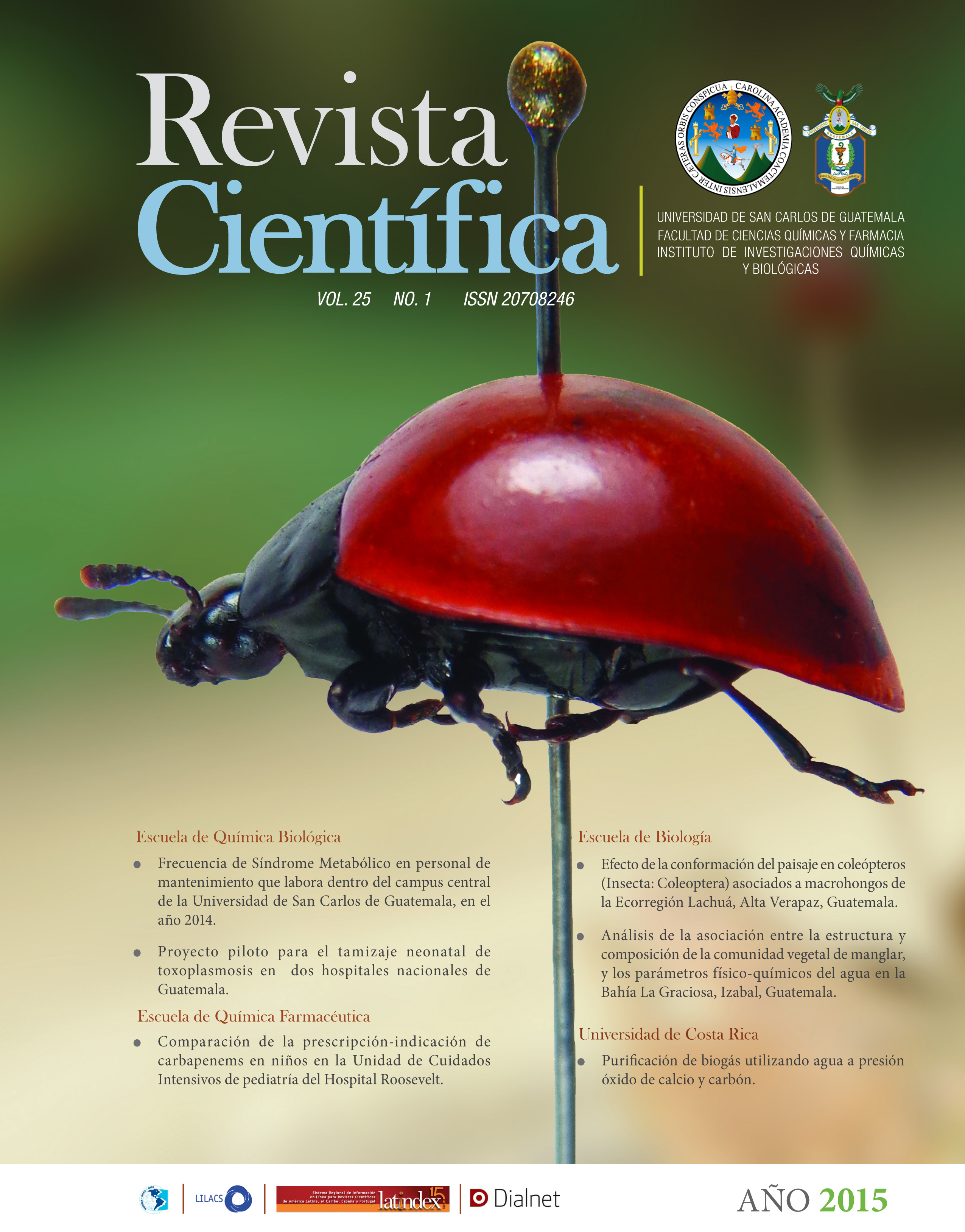Pilot project for neonatal screening of toxoplasmosis in two public hospitals of Guatemala
DOI:
https://doi.org/10.54495/Rev.Cientifica.v25i1.94Keywords:
congenital toxoplasmosis, risk factors, screening, IgM anti-T. gondii antibodiesAbstract
The aim of this study was to perform the neonatal screening for congenital toxoplasmosis through the determination of IgM anti-T. gondii antibodies in newborns who were born in two public hospitals of the departments Guatemala and Sacatepéquez. The Enzyme-linked immunosorbent assay (ELISA) was employed for the analysis of samples. We also collected data on the risk factors associated with the infection, using an epidemiological form with previous consent. A total of 499 newborns were screened and one case was found positive for IgM anti-T. gondii antibodies, which equals to a frequency of 0.2% in the population studied. This positive case was a girl who was born at 35 weeks of gestation and weighed 5 pounds. Although she did not show any sign of infection, she was remitted to a physician for treatment and medical control. Her mother stated that she had no prenatal care during her pregnancy; also, she has a cat as a pet and previously had a spontaneous abortion. Due to the presence of one single case of congenital toxoplasmosis, we were unable to obtain any inference regarding the risk factors. However, the presence of a cat in the family environment of the positive case could have a link with the detection of the antibodies. Screening for the infection in pregnant women was implemented in both hospitals and the medical staff was trained to perform this technique. It is important to continue with the neonatal screening to eliminate the risk of congenital toxoplasmosis among the population who seek medical attention in these hospitals.
Downloads
References
Ambroise-Thomas, P., Schweitzer, M., Pinon, J. M., & Thiebaugeorges, O. (2001). Prevention of congenital toxoplasmosis in France. Risk assessment. Results and perspectives of prenatal screening and newborn follow up]. Bulletin de l’Académie Nationale de Médecine, 185(4), https://doi.org/10.1016/S0001-4079(19)34515-7 DOI: https://doi.org/10.1016/S0001-4079(19)34515-7
Azofeifa Soto, R. (2010). Toxoplasmosis y embarazo. Revista Médica de Costa Rica y Centroamérica LXVII.
Diaz, M. (2013). Adaptación y evaluación de un ensayo inmunoenzimático para la determinación de Toxoplasmosis neonatal (Tesis de Licenciatura). Facultad de Ciencias Químicas y Farmacia, Universidad de San Carlos de Guatemala.
Dunn, D., Wallon, M., Peyron, F., Petersen, E., Peckham, C., & Gilbert, R. (1999). Mother-to-child transmission of toxoplasmosis: risk estimates for clinical counselling. Lancet, 353(9167), 1829–33. https://doi.org/10.1016/S0140-6736(98)08220-8 DOI: https://doi.org/10.1016/S0140-6736(98)08220-8
Durlach, R., Kaufer, F., Carral, L., Freuler, C., Ceriotto, M., Rodriguez, M., Guarnera, E. (2008). Consenso Argentino de toxoplasmosis congenita. Medicina (B. Aires), 68(1), 75–87.
González-González N.L. y González L. (2003). Programas de prevencion de la toxoplasmosis congenita. Actitud Diagnóstica-Terapéutica, 27(1), 37–52.
Jones, J. L., Lopez, A., Wilson, M., Schulkin, J., & Gibbs, R. (2001). Congenital toxoplasmosis: a review. Obstetrical & Gynecological Survey, 56, 296–305. https://doi.org/10.1097/00006254-200105000-00025 DOI: https://doi.org/10.1097/00006254-200105000-00025
Kaye, A. (2011). Toxoplasmosis: Diagnosis, treatment, and prevention in congenitally exposed infants. Journal of Pediatric Health Care, 25, 355–364. https://doi.org/10.1016/j.pedhc.2010.04.008 DOI: https://doi.org/10.1016/j.pedhc.2010.04.008
Lebech, M., Andersen, O., Christensen, N. C., Hertel, J., Nielsen, H. E., Peitersen, B., Petersen, E. (1999). Feasibility of neonatal screening for toxoplasma infection in the absence of prenatal treatment. Danish Congenital Toxoplasmosis Study Group . Lancet, 353(9167), 1834–7. https://doi.org/10.1016/S0140-6736(98)11281-3 DOI: https://doi.org/10.1016/S0140-6736(98)11281-3
McLeod, R., Kieffer, F., Sautter, M., Hosten, T., & Pelloux, H. (2009). Why prevent, diagnose and treat congenital toxoplasmosis? Memorias Do Instituto Oswaldo Cruz, 104, 320 –344. https://doi.org/10.1590/S0074-02762009000200029 DOI: https://doi.org/10.1590/S0074-02762009000200029
Montoya, J. G., & Liesenfeld, O. (2004). Toxoplasmosis. Lancet, 363, 1965–1976. https://doi.org/10.1016/S0140-6736(04)16412-X DOI: https://doi.org/10.1016/S0140-6736(04)16412-X
Pereira, K. S., Franco, R. M. B., & Leal, D. A. G. (2010). Transmission of toxoplasmosis (Toxoplasma gondii) by foods. Advances in Food and Nutrition Research, 60, 1–19. https://doi.org/10.1016/S1043-4526(10)60001-0 DOI: https://doi.org/10.1016/S1043-4526(10)60001-0
Petersen, E. (2007). Toxoplasmosis. Seminars in Fetal & Neonatal Medicine, 12, 214–223. https://doi.org/10.1016/j.siny.2007.01.011 DOI: https://doi.org/10.1016/j.siny.2007.01.011
Remington, J. S., Thulliez, P., & Montoya, J. G. (2004). Recent developments for diagnosis of toxoplasmosis. Journal of Clinical Microbiology, 42(3), 941–5. https://doi.org/10.1128/JCM.42.3.941-945.2004 DOI: https://doi.org/10.1128/JCM.42.3.941-945.2004
Schmidt, D. R., Hogh, B., Andersen, O., Fuchs, J., Fledelius, H., & Petersen, E. (2006). The national neonatal screening programme for congenital toxoplasmosis in Denmark: results from the initial four years, 1999-2002. Archives of Disease in Childhood, 91(8), 661–665. https://doi.org/10.1136/adc.2004.066514 DOI: https://doi.org/10.1136/adc.2004.066514
Downloads
Published
How to Cite
Issue
Section
License
Copyright (c) 2015 M. Aresti, E. Guerra, K. Lange, V. Matta, J. Pensamiento

This work is licensed under a Creative Commons Attribution 4.0 International License.
Authors who publish with this journal agree to the following terms:
- Authors retain copyright and grant the journal right of first publication with the work simultaneously licensed under a Creative Commons Attribution License 4.0 that allows others to share the work with an acknowledgement of the work's authorship and initial publication in this journal.
- Authors are able to enter into separate, additional contractual arrangements for the non-exclusive distribution of the journal's published version of the work (e.g., post it to an institutional repository or publish it in a book), with an acknowledgement of its initial publication in this journal.
- Authors are permitted and encouraged to post their work online (e.g., in institutional repositories or on their website) prior to and during the submission process, as it can lead to productive exchanges, as well as earlier and greater citation of published work.









